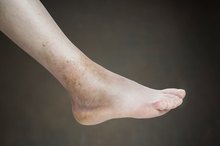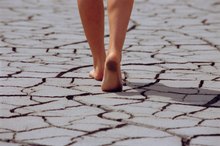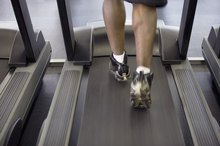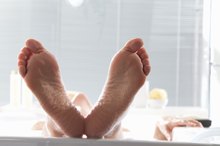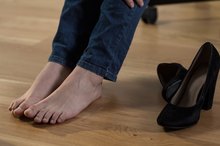What does fact checked mean?
At Healthfully, we strive to deliver objective content that is accurate and up-to-date. Our team periodically reviews articles in order to ensure content quality. The sources cited below consist of evidence from peer-reviewed journals, prominent medical organizations, academic associations, and government data.
The information contained on this site is for informational purposes only, and should not be used as a substitute for the advice of a professional health care provider. Please check with the appropriate physician regarding health questions and concerns. Although we strive to deliver accurate and up-to-date information, no guarantee to that effect is made.
Blisters Caused by Water Retention
Water retention is caused by excess fluid building up in the tissues of your body. This fluid buildup, known as edema, may cause swelling in the area affected. Severe water retention may cause blisters when the fluid becomes trapped under your skin.
Accumulation of Fluid in Your Body
Leakage of fluid from your capillaries can signal your kidneys to slow production of urine. This causes more fluid to build up in your system and more pressure in your capillaries, which causes more leakage. Your capillaries may leak fluid because they are damaged or if the pressure within them is high. If your level of serum albumin, a protein in your blood, is low, your kidneys will retain more sodium and fluid. These actions cause fluid to accumulate and water retention occurs.
- Leakage of fluid from your capillaries can signal your kidneys to slow production of urine.
- If your level of serum albumin, a protein in your blood, is low, your kidneys will retain more sodium and fluid.
What Causes Water Retention?
How to Exercise for Water Retention
Learn More
Some of the reasons you may retain water include eating salty foods, standing or sitting in one position for a long period of time, hormone changes from premenstrual syndrome and pregnancy. Some medications also may cause swelling. These include vasodilators used to open blood vessels, commonly used in blood pressure regulating medications. Calcium channel blockers. also known as calcium antagonists, a blood pressure regulating medication, may cause water retention. Thiazolidinediones, a form of diabetes medication, and nonsteroidal anti-inflammatory drugs also may cause you to retain water.
- Some of the reasons you may retain water include eating salty foods, standing or sitting in one position for a long period of time, hormone changes from premenstrual syndrome and pregnancy.
Symptoms of Water Retention
Blisters on the skin are a sign of severe water retention. This is caused by fluid being trapped under the skin and gathering in blisters. If blisters appear, they may break and leak fluid. Other symptoms include swelling of the ankles, legs, face or other areas of the body. Pitting edema is characterized by a dimple forming when you push on your skin. Your skin may become shiny or look stretched. A noticeable and unexplained increase in the size of your abdomen may be a symptom of water retention.
- Blisters on the skin are a sign of severe water retention.
Serious Symptoms
Causes of Swelling in Legs, Hands & Feet
Learn More
If you experience shortness of breath, difficulty in breathing or chest pain, you may have developed water retention in your lungs. This may be a condition called pulmonary edema and is life-threatening. According to the Mayo Clinic, you should seek medical help immediately if you develop these symptoms 1.
Treatment for Water Retention
Your doctor may prescribe medications that will help your body to release the built-up fluid. These are diuretics, and they help your kidneys increase the flow of urine. Your doctor may suggest that you wear pressure stockings if you have water retention in your legs. These stockings will help to squeeze the fluid out of your legs and keep fluid from accumulating. Resting with your legs raised above your heart may help your lymphatic system drain the excess fluid from your legs. Limiting salt in your diet may be a course of action that your doctor recommends. You may prevent swelling in your legs by not sitting or standing in one place for a long period of time. According to the Mayo Clinic, the movement of your leg muscles will help prevent fluid from building up 1.
- Your doctor may prescribe medications that will help your body to release the built-up fluid.
Related Articles
References
- Mayo Clinic
- Kwon C, Lee HY, Kim MG, Boo SH, Yeo SG. Allergic diseases in children with otitis media with effusion. Int J Pediatr Otorhinolaryngol. 2013;77(2):158-61. doi:10.1016/j.ijporl.2012.09.039
- Qureishi A, Lee Y, Belfield K, Birchall JP, Daniel M. Update on otitis media - prevention and treatment. Infect Drug Resist. 2014;7:15-24. doi:10.2147/IDR.S39637
- American Academy of Otolaryngology-Head and Neck Surgery. Treating and Managing Ear Fluid. http://www.entnet.org/sites/default/files/uploads/PracticeManagement/Resources/_files/ome-treating-managing_cobranded.pdf.
- Otitis media with effusion. Medline Plus website. https://medlineplus.gov/ency/article/007010.htm. Updated August 31, 2016.
- Rosenfeld, RM, Shin, JJ, Schwartz, SR, Coggins, R, Gagnon, L, Hacker, JM ... Corrigan, MD. (2016).Clinical Practice Guideline: Otitis Media with Effusion (Update). Otolaryngology– Head and Neck Surgery. 154(1S) S1–S4.
Writer Bio
Kathryn Pless lives in rural Florida and is a licensed cosmetologist and nail technician. She has had articles published in Nails Magazine and also had poetry published in The Sandhill Review, the literary journal of Saint Leo University.

